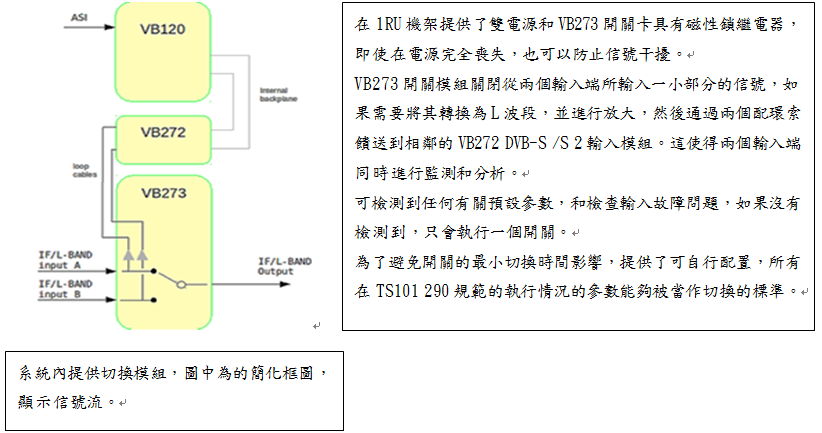VB273

VB273 SATELLITE UPLINK REDUNDANCY SOLUTION
- IF and L-BAND
VB273 DVB-S / S2 satellite signal intelligent main and standby automatic switching system. The complete VB273 system is composed of VB120 controller module, VB272 monitoring module and VB273 switching module. Used for IF or L-Band signal and monitoring standards (ETSI TR 101 290).
VB273 contains dual-path satellite signal channels, providing an intelligent switching system that includes autonomous operation and in-depth signal analysis for final switching decisions. The solution is to provide an ideal fast and powerful switching mechanism for a permanent installation on the satellite station link or outdoor broadcast system.

The picture shows a complete VB273 system and VB120 controller, 10/100/1000 technical management interface, USB-RS232 for initial settings, VB272-SMA DVB-S / S2 and VB273 switch in a 1RU EC AC power supply rack, this This configuration requires only 25W of power, which is quite power efficient.
The picture shows a 1RU enhanced machine with a VB120 module and two VB252 DVB-T / T2 input modules, a total of 4 independent RF inputs.
In addition to monitoring typical RF parameters, optional advanced data in the complex DVB-T MI protocol; signal integrity is based on the verification layer. In addition, VB252 also supports T2 Lite standard accelerator for comprehensive analysis. All analysis functions integrate bridge technology and ETSI TR101290 monitoring engine to ensure compliance with standards.

In manual mode, it can be controlled from the upper layer network management system based on the extensive XML-based EII (External Integrated Interface), or through SNMP.
The VB273 also has a unique super Local mode function. In an emergency, the network control can be cut off through the manual control panel buttons, and all parameters can be controlled through the built-in Web interface. The Web GUI contains a visual interface and provides parameters used in switching decisions and system status.
The VB120 provides support for TS 101 290 analysis. In addition to the two main ASI input ports required by VB242, it can also be used to temporarily monitor the ASI input port.
The hardware architecture is in compliance with carrier-grade standards and can achieve the highest reliability. The complete solution requires only 25W of power consumption, which can relatively reduce the power consumed during installation to achieve power saving.
Technical characteristics
- 2:1 redundancy switching functionality based on built-in monitoring of incoming satellite signals
- Monitoring feature set of VB120 included making this a switch and a probe combined into one
- Supports 70/140MHz IF (VB273) and 950-2150MHz L-band (VB273-LBAND)
- IF signal inputs: 75 ohm female BNC; IF signal output: 75 ohm female BNC
- L-BAND signal inputs: 50 ohm female SMA ; L-BAND signal output: 50 ohm female SMA
- Three-stage button logic supporting 3 distinct modes: Manual, Auto, Super Local
- Robust bistable RF relays ensures state is preserved even in the event of a power loss
- Passive loop through so that signal is passed even if no power on unit
- Capable of receiving DVB-S/S2 QPSK, DVB-S2 8PSK, DVB-S2 16APSK, DVB-S2 32APSK
- Continuously monitor and switch on all TR 101 290 priority 1, 2 and 3 parameters (except Buffer Fill)
- Possibility to customise alarming and switching template on all parameters
- Independent alarm template and redundancy switching template to allow a parameter to be alarmed on while at the same time not resulting in a redundancy switch
- Filtering capabilities on switching criteria to prevent short glitches to trigger a redundancy switch
- Continuously monitor and switch on RF parameters:
- Channel power RF level
- Modulation Error Rate (MER) in dB
- Signal to Noise Rate (SNR) in dB
- Error Vector Magnitude (EVM) in% and in dB
- BER pre Viterbi (for DVB-S)
- BER post Viterbi (for DVB-S)
- BER post LDPC-BCH (for DVB-S2)
- RS Packet Error Count
- Carrier frequency offset
- Symbol rate offset - PID analysis, Service analysis, bandwidth overview, PSI/SI/PSIP table analysis
- Automatic or manual TS recording of up to 200MB for recording fault that triggered redundancy switch
- Thumbnail extraction with audio bars and meta data
- Configurable alarm severity level
- PSIP support (ATSCA/78)
- Exportable logs
- Management port: 10/100/1000-T; Video ports for RDP relay: 10/100/1000-T and SFP
- Condensed mosaic thumbnail view of all services monitored





